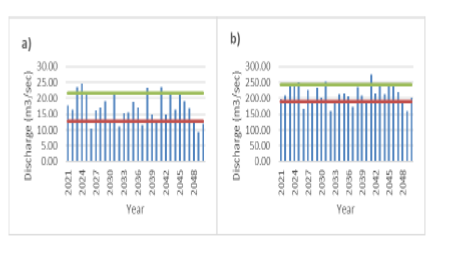


Indian Journal of Science and Technology
Year: 2022, Volume: 15, Issue: 29, Pages: 1458-1465
Original Article
Shilpa A Veerabhadrannavar1*, B Venkatesh2
1National Institute of Hydrology, Hard Rock Regional Centre, Visvesvaraya Nagar, Belagavi, Karnataka 590019, India.
2National Institute of Hydrology, Hard Rock Regional Centre, Visvesvaraya Nagar, Belagavi, Karnataka 590019, India
*Corresponding author
Email: [email protected]
Received Date:17 April 2022, Accepted Date:13 June 2022, Published Date:01 August 2022
Objectives: Precipitation is a major component of the hydrological cycle. Precipitation varies in intensity throughout time and space. The discharge at the outlet of the catchment is directly proportional to the precipitation received in the catchment. The current research looks at the precipitation as well as discharge patterns in the Sagar and Kokkarne catchments in the Western Ghats of Karnataka, India. Methods: In the present research, the soil water assessment tool (SWAT) has been applied to monitor and quantify the streamflow of the Sagar and Kokkarne catchments. Precipitation and discharge analysis for the period of 2021-2050 for both of the catchments is carried out. The seasonal and yearly discharge patterns of the catchments were studied using the Coordinated Regional Downscaling Experiment-South Asia data for the RCP 4.5 scenario for the period 2021-2050. Findings: During the Southwest monsoon and Northeast Monsoon, about 81.44 % and 14.22 % of the precipitation in Sagar catchment and about 87.34 % and 6.93 % of the precipitation in Kokkarne catchment were obtained respectively. The contribution of the Southwest Monsoon in both the catchment is greatest, followed by the Northeast monsoon. During the period 2021-2050, less than 80 % probability of discharge is expected for 23 years and more than 20 % probability of discharge is expected for 4 years. The maximum discharge expected in Sagar and Kokkarne catchments are 16.96 m3/sec and 213.87 m3/sec respectively. Novelty: The patterns of the precipitation and discharge of two different catchments on each side of the Western Ghats of Karnataka are compared in the current study to understand the impact of climate change on catchment hydrology in these regions.
© 2022 Veerabhadrannavar & Venkatesh. This is an open-access article distributed under the terms of the Creative Commons Attribution License, which permits unrestricted use, distribution, and reproduction in any medium, provided the original author and source are credited.
Published By Indian Society for Education and Environment (iSee)
Subscribe now for latest articles and news.